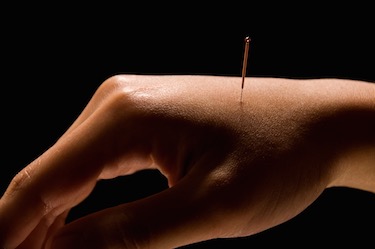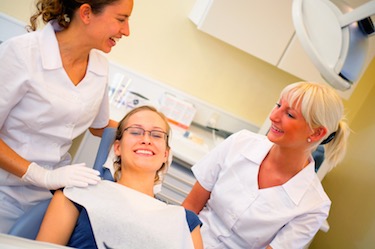Acupuncture reduces tooth socket bone loss due to periodontitis. Researchers conducting a laboratory experiment on the effects of periodontitis discovered that electroacupuncture decreases periodontal tissue destruction and also reduces pro-inflammatory mediators and a key pro-resorptive factor. Histomorphometry and microtomography confirm that electroacupuncture effectively reduces bone loss in the alveoli, the jawbone sockets containing the roots of teeth. The research was published in the Journal of Periodontology Online, an official publication of the American Academy of Periodontology. 
The researchers identified key biochemical reductions in pro-inflammatory mediators. Application of electroacupuncture decreased expression of IL-1β, a pro-inflammatory cytokine, which is a cell-signaling protein used in intercellular communication. Zhe Liu et al. also measured reductions in IL-1β caused by the application of acupuncture. In an entirely different experiment on a different set of acupuncture points, GV20 and GB7, Zhe Liu et al. found that acupuncture reduces IL-1β in the brain tissue region of a hematoma after a stroke.
The periodontal experiment conducted by Lisboa et al. examined the effects of electroacupuncture on laboratory mice with ligature induced periodontitis. Acupuncture points LI4 (Hegu), LI11 (Quchi), ST36 (Zusanli) and ST44 (Neiting) were applied. The researchers identified another pro-inflammatory modulator that was downregulated by the application of acupuncture at these points. Expression of MMP-8 decreased. MMP-8 is a protein active in the breakdown of extracellular matrixes.
About the Acupuncture Points
All acupuncture points chosen for use in the periodontitis study were selected from either the large intestine hand-yangming or stomach leg-yangming channels. The stomach leg-yangming channel traverses several areas related to oral health. The primary stomach channel begins beside the nose near the ala nasi at LI20 and ascends to the root of the nose where it intersects with UB1. Next, the channel descends along the lateral side of the nose and enters the upper gums. Then, it joins acupuncture point DU26 and circles back around the corner of the mouth, meeting CV24 at the mentolabial groove. From there, it follows the angle of the jaw and runs upward in front of the ear. Another branch separates on the lower jaw and descends along the throat and enters the supraclavicular fossa.
The large intestine hand-yangming channel traverses areas relating to oral health. A branch separates from the main channel at the supraclavicular fossa and moves upward through the neck, crosses the cheek and enters the lower gums. Next, it curves around the lips and intersects the same channel coming from the opposite side of the body at the philtrum. The branch terminates at the side of the nose.
According to Traditional Chinese Medicine (TCM) principles, LI4 is a source point and an entry point. It functions to disperse wind, releases the exterior by diaphoresis, suppresses pain, and clears the channels. LI4 is indicated for use in the treatment of headaches, eye pain, toothaches, epistaxis, deafness, facial edema, facial paralysis, sore throat, trismus, fever, and delayed labor. LI4 is traditionally combined with LV3 for moving qi and suppressing pain. LI4 is traditionally combined with KD7 for the treatment of insufficient sweating or anhidrosis. 
TCM principles indicate that LI11 is a he sea, earth and ghost point. It eliminates wind, releases the exterior, cools heat, alleviates dampness and regulates the blood. LI11 is indicated for the treatment of sore throat, toothache, red and painful eyes, goiter, dermatological conditions including urticaria, upper limb paralysis, and febrile diseases.
ST36 is a he sea, earth, lower he sea of the stomach, and sea of nourishment point. ST36 orders the spleen and stomach, regulates qi and blood, and strengthens cases of weakness and deficiency. ST36 is indicated for the treatment of gastric pain, vomiting, abdominal distention, diarrhea, constipation, mastitis, enteritis, edema, asthma, exhaustion, anemia, hemiplegia, and neurasthenia.
ST44 is a ying spring and water point. It cools and drains stomach heat, regulates qi, and suppresses pain. ST44 is indicated for the treatment of toothache, trigeminal neuralgia, mouth paralysis, sore throat, tonsilitis, epistaxis, gastric pain, abdominal pain and distention, diarrhea, dysentery, and febrile diseases.
References:
Lisboa, Mario RP, Delane V. Gondim, Edilson Ervolino, Mariana Vale, Nicolly PR Frota, Nara LT Nunes, Viviane Mariguela, Mario Taba Jr, Michel R. Messora, and Flávia AC Furlaneto. "Effects of Electroacupuncture on Experimental Periodontitis in Rats." Journal of Periodontology 0 (2015): 1-19.
History and Mechanism for Treatment of Intracerebral Hemorrhage with Scalp Acupuncture. Zhe Liu, Ling Guan, Yan Wang, Cheng-Long Xie, Xian-Ming Lin and Guo-Qing Zheng. The Third Clinical College of Zhejiang Chinese Medical University, Hangzhou. Department of Acupuncture and Moxibustion, General Hospital, Beijing. Center of Neurology and Rehabilitation, The Second Affiliated Hospital of Wenzhou Medical College, Wenzhou.


